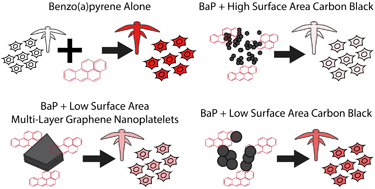Impact of emerging, high-production-volume graphene-based materials on the bioavailability of benzo(a)pyrene to brine shrimp and fish liver cells†
Abstract
With increasing commercialization of high volume, two-dimensional carbon nanomaterials comes a greater likelihood of environmental release. In aquatic environments, black carbon binds contaminants like aromatic hydrocarbons, leading to changes in their uptake, bioavailability, and toxicity. Engineered carbon nanomaterials can also adsorb pollutants onto their carbon surfaces, and nanomaterial physicochemical properties can influence this contaminant interaction. We used 2D graphene nanoplatelets and isometric carbon black nanoparticles to evaluate the influence of particle morphology and surface properties on adsorption and bioavailability of benzo(a)pyrene, a model aromatic hydrocarbon, to brine shrimp (Artemia franciscana) and a fish liver cell line (PLHC-1). Acellular adsorption studies show that while high surface area carbon black (P90) was most effective at a given concentration, 2D graphene nanoplatelets (G550) adsorbed more benzo(a)pyrene than carbon black with comparable surface area (M120). In both biological models, co-exposure to nanomaterials lead to reduced bioavailability, and G550 graphene nanoplatelets caused a greater reduction in bioavailability or response than the M120 carbon black nanoparticles. However, on a mass basis the high surface area P90 carbon black was most effective. The trends in bioavailability and adsorption were consistent across all biological and acellular studies, demonstrating the biological relevance of these results in different models of aquatic organisms. While adsorption is limited by surface area, 2D graphene nanoplatelets adsorb more benzo(a)pyrene than carbon black nanoparticles of similar surface area and charge, demonstrating that both surface area and shape play important roles in the adsorption and bioavailability of benzo(a)pyrene to carbon nanomaterials.



 Please wait while we load your content...
Please wait while we load your content...